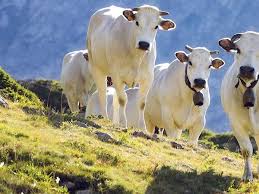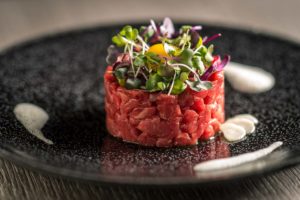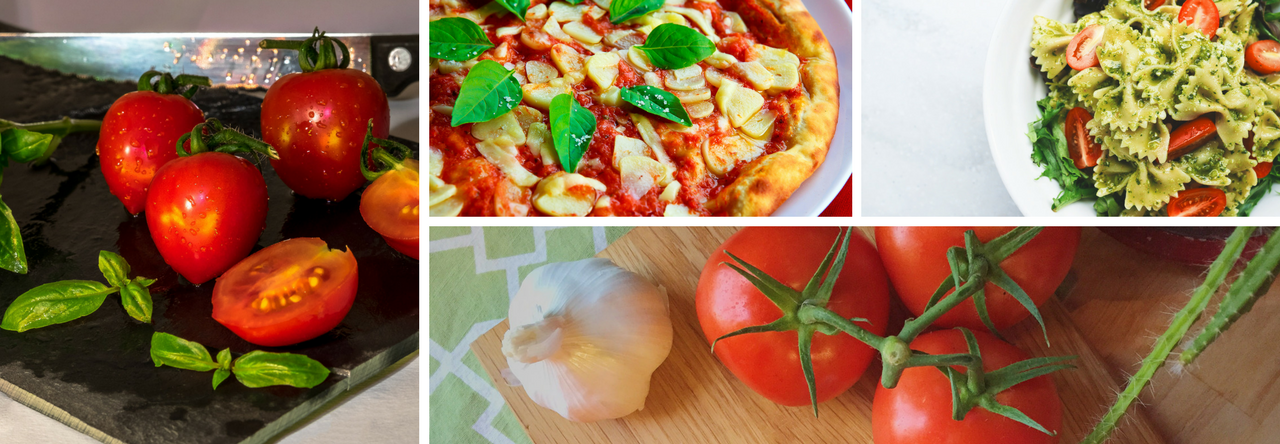
The fassona is a breed of white cow that appeared in the late 1800s in Piedmont characterized by muscle hypertrophy resulting in a “groppa di cavallo” (horse rump). Recent genetic studies revealed that the muscular hypertrophy typical of this breed is caused by inherited germline inactivation of the myostatin gene whose function is to stop muscle growth. Therefore, these cows have muscle hypertrophy and their meat is leaner than others. (So it is ideal for those who watch their diet).
Since it may be difficult to find this meat, just buy a good filet and be sure the butcher –or you–trims out all the fat. This recipe is the simplest tartar steak you can think of. If you look in cookbooks and internet you will find an infinite list of recipes to make this tartare. Most of the recipes are not worth the time it takes to try them.
A few weeks ago, I ate at the Restaurant “San Carlo” in New York City’s Soho, where Stefano, the chef, made the best Battuta I have ever had. I came back three times in one week!
So as soon as I got home (Hawaii) I made it—outstanding! Here is Stefano’s recipe –which is now one of my preferred dishes.
Ingredients
- 1 filet mignon/person –the size you wish depending on how hungry you are.
- 3 chives per each filet mignon only the white part and the beginning of the stalk, chopped about ½ cm a piece
- 1 peeled lemon zest per each filet
- Salt to taste and and a little bit of olive oil, about 1 teaspoon
Recipe
- Put the chopped chives in a small pan with 1 teaspoon of olive oil, cook covered, low heat, about 15 minutes. When ready put in the freezer to cool for 2-3 min.
- As the chives cook, peel the zest of 1 lemon for each filet.
- Chop the meat, you need a well sharpened knife.
- Mix the lemon zest with the chopped meat, add the chopped chives with 1 teaspoon of olive oil, add salt to taste.
- DONE! Plate it and enjoy!
You need also some good bread and a good

Battuta Di Fassone
Piemontese wine (Barbaresco, Barolo, Barbera, Dolcetto, or if you can find it a good “langhe” which is a cheaper wine which can be outstanding or so-so depending on who makes it and the year).
Do NOT add grated parmigiano cheese as suggested by most recipes on the internet.
Italian: La Battuta di Fassona
È probabilmente la tartara più semplice da preparare, e se la carne è buona e la preparate come vi dico è buonissima.
Troverete tante ricette differenti nei libri e nell’internet, lasciate perdere, la ricerca l’ho fatta io per voi perché girando il mondo la ordino sempre. La più buona l’ho mangiata, a New York, a Soho, nel Ristorante San Carlo Osteria Piemonte, dove Stefano lo Chef mi ha insegnato a farla così.
Allora la fassona è una razza di vacche bianche piemontesi con una caratteristica gobba causata da una mutazione del gene “miostatin” a che quando inattivato non può bloccare lo sviluppo dei muscoli che quindi continuano a crescere: cioè queste vacche hanno una ipertrofia muscolare. Perciò la carne di queste vacche è molto più magra della carne di altre vacche –ottima se siete a dieta.
Se non trovate la “fassona” vi troverete benissimo con un filetto di un animale che pascola e mangia l’erba, non di quelli che stanno chiusi in allevamento e mangiano granoturco!
Ingredienti
- 1 filetto per persona, la grandezza dipende dall’appetito, mettetelo in freezer circa mezz’ora prima di tagliarlo, sarà tutto più facile
- 3 cipolline verdi lunghe tagliate a pezzettini piccoli di ½ cm circa
- 1 limone, solo la buccia grattata, niente bianco!
Preparazione
- Soffriggere in un po’ di burro, un cucchiaio, a fuoco basso tenendo la pentola coperta le cipolline a pezzetti finche diventano translucide, circa 15 minuti. mettete in freezer per 2-3 minuti per raffreddarle.
- Mentre cuoce la cipollina, tagliate la carne, vi serve un coltello bene affilato, tagliatela a fette sottilissime –perciò avete messo il filetto nel freezer- e poi continuate a tagliarlo finché è come carne tritata. Ma per carità fatelo a mano, non nel tritatutto!
- Mischiate con le mani la carne tritata con la scorza di limone e le cipolline –non il burro- aggiungete un po’ di sale, e un cucchiaino da te di olio. Formate una bistecca rotonda o come vi pare, mettetela nel piatto e buon appetito. Se volete aggiungete poco olio di oliva.
- Niente altro, incluso niente Parmigiano che molti raccomandano ma che secondo me rovina la delicatezza meravigliosa di questo piatto.
Vino: Barbaresco, perché lo preferisco, ma naturalmente vanno benissimo tutti i vini Italiani (buoni) rossi, meglio piemontesi visto che la ricetta viene da li.


